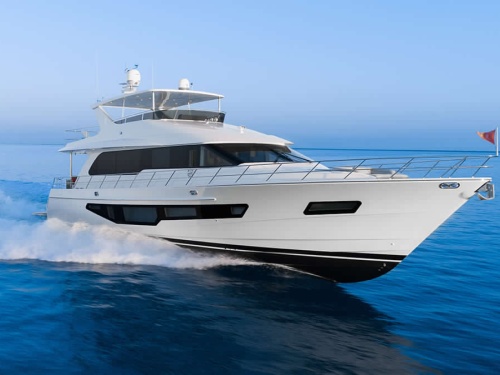Access More Boat Tests
Already have an account? Login
CL Yachts CLA76 Flybridge (2019-)
2 x 1,136-hp Caterpillar C-18 ACERTs
Brief Summary
The CLA76 from CL Yachts is a motoryacht built to a high construction standard for optimal performance for cruising or welcoming guests aboard for a leisure day and evening entertainment. CL Yachts is the rebranded luxury yacht division of Cheoy Lee Shipyards, a well-established builder. Since the initial introduction of this yacht, she has evolved with design enhancements that include a longer superstructure and a refined interior.
Key Features
- 10-year hull structure warranty
- Sun shades with 60mm carbon fibre poles for fore, aft and flybridge decks
- Table on aft deck
- Teak decking on swim platform and stairs
- Flybridge Dual Stidd low back Admiral helm seats with ‘Pelican’ Ultraleather cover
- Flybridge L-shaped lounge seat with Sunbrella covers
- Aurora gas grill with stainless steel cooking grids and 10-lb. (4.54 kg) aluminum gas tank
- Two banks of 2 x 8D Lifeline AGM batteries for engine start and domestic service
- Salon entertainment center with 46” (116.84 cm) pop-up television
- King berth with upholstered headboard and storage under berth
Test Results
| RPM | MPH | Knots | GPH | MPG | NMPG | STAT. MILE | NM | dBa |
|---|---|---|---|---|---|---|---|---|
| 600 | 8.1 | 7 | 6 | 1.3 | 1.2 | 1269 | 1103.3 | 69 |
| 1000 | 11.6 | 10.1 | 14 | 0.8 | 0.7 | 784 | 682 | 63 |
| 1250 | 14.2 | 12.4 | 21 | 0.7 | 0.6 | 639 | 556 | 67 |
| 1500 | 17.8 | 15.5 | 43 | 0.4 | 0.4 | 391 | 339.8 | 66 |
| 1750 | 22.8 | 19.8 | 63 | 0.4 | 0.3 | 342 | 297.2 | 69 |
| 2000 | 28.5 | 24.8 | 89 | 0.3 | 0.3 | 302 | 263 | 75 |
| 2200 | 31.7 | 27.6 | 109 | 0.3 | 0.3 | 275 | 239 | 74 |
| 2400 | 34.2 | 29.7 | 118 | 0.3 | 0.3 | 274 | 238 | 76 |

Specifications
| Length Overall |
77’7” 23.65 m |
|---|---|
| Beam |
19’ 8'' 5.99 m |
| Dry Weight |
107,000 lbs. 48,534 kg |
| Tested Weight |
110,854 lbs. 50,283 kg |
| Draft |
5' 4'' 1.63 m |
| Max Headroom | open |
| Fuel Capacity |
1,100 US gal. 4,150 L |
| Water Capacity |
290 US gal. 1,100 L |
| Total Weight |
110,854 lbs. 50,283 kg |
Acceleration Times & Conditions
| Time to Plane | 9.7 sec. |
|---|---|
| 0 to 30 | 12.6 sec. (0 to 20) |
| Load | 4 persons, 1/5 fuel, 3/4 water, 50 lbs. of gear |
| Climate | 86 deg., 86 humid.; wind: 2-15 mph; seas: 2-4 |
Engine Options
| Tested Engine |
2 x 1,136-hp Caterpillar C-18 ACERTs |
|---|---|
| Std. Power |
2 x 1,136-hp Caterpillar C18 diesels |
Warranty
| Hull Warranty Extended | 2 year limited plus 10 year structural hull |
|---|
Captain's Report
Contents of Report
Mission
The CLA76 Flybridge is a motoryacht that can cruise or go down island, take large groups of guests aboard for dayboating in her numerous distinct social areas, and sleep eight guests in comfort in four-staterooms. The boat is engineered to cruise at a range of speeds and is built to be light and strong to optimize her fuel efficiency and range. While fitted with crew’s quarters, the CLA76 Flybridge would be a good choice for an experienced owner/operator, as her systems are easy to use.

Major Features
- Strong lightweight hull construction using foam coring, carbon fiber, e-glass, and vinylester resin.
- Engine room design makes the most of the space, creating accessibility to system and centralizing sound and vibration attenuation.
- TNT two-stage swim platform can ship a tender, lift up to 1,500 lbs. (680 kg) and raises as well as lowers with respect to the standard position.
- ZF wired remote control makes docking simple by granting control to the main engine throttle and shift and bow and stern thrusters without relying on radio signal or sightlines from a fixed aft station.
- Crew’s quarters mean there’s another berth and head for a nanny, a cook, or even a child or grandchild who needs a little space.
Features Inspection

Swim Platform
The swim platform measures 7’ (2.13 m) long and is a two-stage, hydraulically actuated model from TNT that can be lowered beneath the water’s surface to let swimmers enjoy the water. It has a 1,500 lb. (680 kg) lifting capacity and can ship a tender.
The platform has hardware to accept chocks for the tender and there are tie-down rings for the purpose. The deck is finished in teak. The second stage allows the platform to raise up to reduce drag while running.

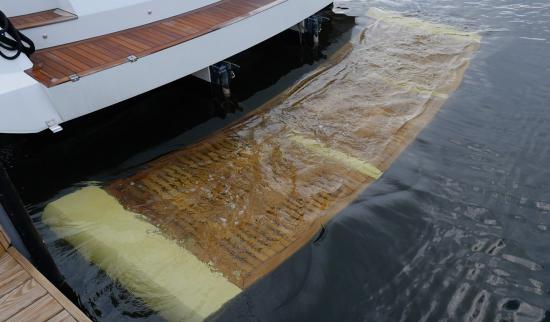

Crew’s Quarters
Crew’s quarters are located aft and are accessed through a door in the transom. This watertight transom door is hinged on the top and has gas-assist rams to help it open easily. It’s designed to be usable even with a tender on chocks on the platform or when the platform is in its elevated position. The door measures 60” by 26½” (152 cm by 67.31 cm) and it’s three steps down to the deck in the crew’s quarters.


The crew’s quarters have headroom varying from 6’1½” to 6’6” (186.7 cm to 198.1 cm). There’s a single port-side berth measuring 77” long by 29” wide (195.6 cm by 73.66 cm) with a hullside window, and the locker doors and cabinetry are finished in wood veneer with horizontal grain. A flat-screen TV is mounted to the aft bulkhead.

In most cases, this will be an owner/operator boat, but the crew’s quarters might be used for kids or grandchildren, providing an extra cabin. It is also comfortable for a mate, nanny or chef. It has a headroom varying from 6’1½” to 6’6” (1.86 m to 1.98 m).

The crew galley is a simple affair, consisting of a half-size refrigerator with counter space on top of it, and a microwave tucked into a corner outside the engine room door.

The wet head compartment is entered through a door in the forward bulkhead of the crew’s quarters. It’s situated athwartships, with a euro-style wand shower and 6’3½” (191.8 cm) headroom. A round stainless steel sink is set into a solid-surface counter atop a locker for toiletries is to port, with a mirror with a medicine cabinet. The Tecma MSD is starboard with a towel bar above.



The ship’s AC and DC electrical system panels are located in the crew’s quarters, in lockers near the crew galley. There are other breaker panels serving the same systems in other locations onboard.


Engine Room
In the crew’s quarters, the engine room door is forward to starboard and measures 64” by 19” (162.6 cm by 48.26 cm) wide. The engine room is well lit as we expect from CL Yachts, which builds some of the best motoryacht engine layouts we have seen.
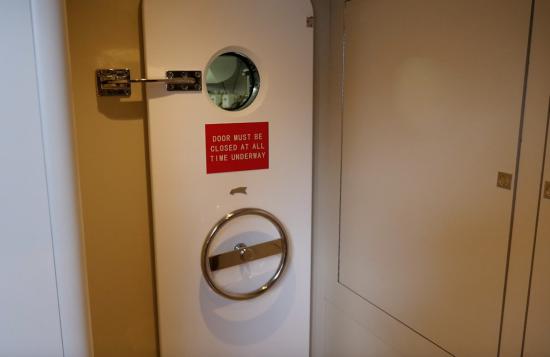
The twin Caterpillar C18 ACERTs are placed 42” (106.7 cm) apart, which is unusually wide for a boat this size. The reason for that is that these two 1,136-hp engines are inline 6-cylinder diesels that are only about 47” (3.02 m) wide. Because the boat is 19’8” (5.99 m) wide, there is plenty of room outboard of the engines, so owner/operators can easily get around in this engine room.
There’s also 35 ½” (.90 m) above the engines, and the overhead is 6’6” (1.98 m) – that’s high enough that if an engine ever needs repair, it can be raised on an A-frame right here in the engine room, and doesn’t need to be taken out. Again, that clearance is unusual on a 76’ (23.16 m) motoryacht. Even with all that space, each diesel has a rugged, powder-coated safety rail to keep crew from falling against a hot engine.

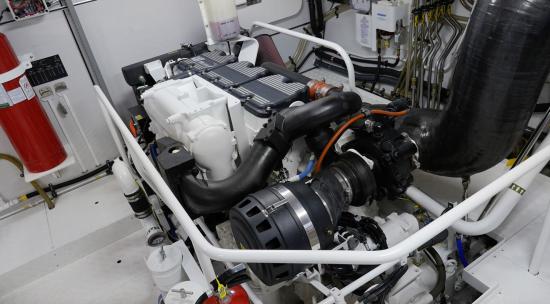
The exhaust systems on this boat are well designed to stay in place and not work on the turbo housing. Four stainless steel supports run from support eyes on the exhaust to the engine mounts, to keep it immobilized.

A sea chest mounted on the centerline reduces the number of necessary through-hulls. Raw water comes into the boat through one opening in the bottom of the boat instead of having one fitting for each of the engines, and two others for the generator and the air conditioning system.
Plumbed to the sea chest, the Groco sea strainers are easy to open and clean, once their ball valves have been turned off. The fittings are all wired for positive protection against galvanic corrosion.

The raw-water hoses for the Dometic chilled water air-conditioning system and the Kohler generator come right off the sea chest so no need to go through contortions to find the shut-off levers to close them.
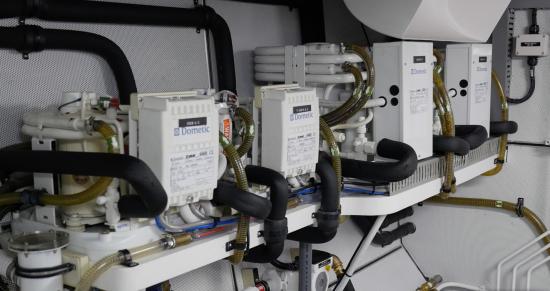
The engine room is designed to tame sound and vibration with the use of Soundown materials and lined with perforated aluminum panels. The builder put all mechanical equipment into the engine room, centralizing the sound and vibration, all the better to corral it in one place.

The Side-Power bow and stern thrusters are hydraulic and much of the system’s equipment is in the engine room where it can be inspected and maintained easily. Here we see the hydraulic hoses attached to the PTO on the ZF marine gears. We like this system better than having electric thrusters because we don’t have to worry about overheating and throwing a breaker.
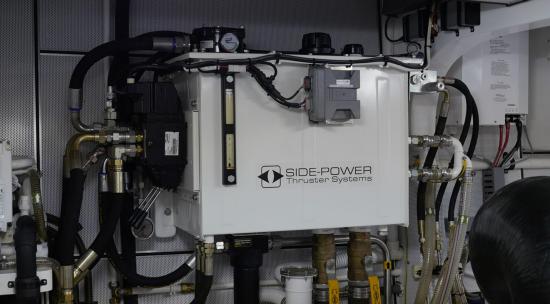


Delta-T demisters make sure that the engine room has plenty of dry air, and they are positioned right above the generator. Inside are delicate plastic vanes that filter water and salt spray out of the air to reduce the chance of corrosion in the engine room. The fans are waterproof and can run indefinitely.

The Sea-Fire automatic fire-suppression system has been calibrated to handle this specific engine room and will discharge its super pressurized nitrogen in less than 10 seconds without harming any of the engine room’s equipment.

Duplex Racor fuel-water separators are a sign of a first-class engine room. Water, dirt, and air are the only things that will shut down these engines and the Racors take care of two of the three. CL Yachts' swaged fittings on all fuel lines eliminate air leaks. In addition, a Reverso fuel-polishing system can head off a bad load of fuel to the tune of 150 gph (567.8 lph).

There are two other entry and exit points to the engine room, a watertight door from the master stateroom closet on the forward bulkhead, and a hatch in the overhead to the aft deck, up a five-step ladder.

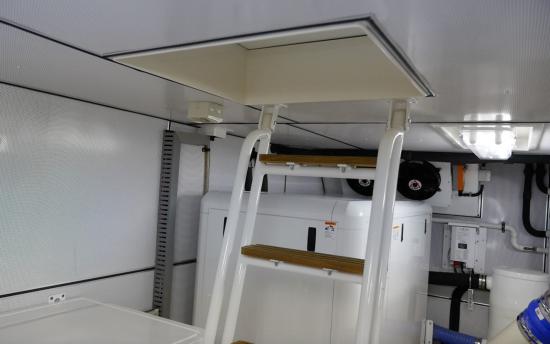
A Word About Construction
The CLA76 Flybridge is one of the lightest flying-bridge motoryachts we have tested her size. Her foam-cored hull is resin-infused and made out of sophisticated carbon fiber and E-glass composite that has been engineered by Gurit, a U.S. company that is a leader in composite applications for aerospace, automotive, and marine.
Water-impervious vinylester resins are used throughout and there is an epoxy barrier on the hull bottom. It is rare that we find a boat in any class with a hull made entirely of expensive vinylester resin. Her tanks are integral to the hull which saves weight and lowers the CG.
Her cabinetry and bulkheads are cored with Tricel honeycomb. All decks are cored with foam and finished top and bottom, a weight savings over the plywood other builders use. Subdeck structures are composite and not plywood.


Transom Features
The shore power cable is retrieved and deployed by an electric Glendinning Cablemaster reel system behind a cover in the starboard aft quarter.

Cleats with stainless steel chafing gear are built into each aft quarter to simplify dockline management. Additional cleats are positioned lower on aft bulwarks by the swim platform.


Aft Deck
Access to the aft deck is up the port and starboard stairs. The stairs to either side are served by a robust stainless steel handrail positioned inboard of the steps. The top of each set of stairs is protected by a tempered glass and stainless steel gate.

The aft deck is sheltered by the overhang of the flying bridge above and has an overhead height of 6’11” (210.8 cm) with recessed LED lights and speakers connected to the Fusion stereo system. The aft deck has a teak sole and measures 7’8” (2.337 m) fore and aft by 16’4” (4.978 m) wide.

Aft-deck boarding doors to port and starboard are built into the bulwarks. They are well designed with recessed, stainless steel pantograph hinges allowing the door to open out. They measure 1’5½” wide (44.45 cm) and ease boarding and egress dockside.


The transom settee measures 108½” wide (275.6 cm) and has a 61½” by 24” (156.2 cm by 60.96 cm) table for al fresco dining on a pair of stainless steel pedestals.

A flat screen TV adds to the entertainment options on the aft deck. The TV is mounted up high in the starboard forward corner and is connected to the KVH TracVision domes on the hardtop over the flybridge.


Side Decks
The CLA76 Flybridge has side decks to either side of the superstructure, one 9 ½” (24.13 cm) step up from the cockpit. There’s a grabrail. The safety rail is 31” (78.74 cm) high for its entire run forward, and there’s LED courtesy lighting along the length of the side deck.
New, Longer House. The CLA76 Flybridge has a longer house now, which gave the company more flexibility inside and more space on the flying bridge. As a design element, the aft house-side windows continue all the way to the aft deck, where they have a stainless steel frame with an integrated vertical grab handle to make it easier for those aboard to get around in a seaway.
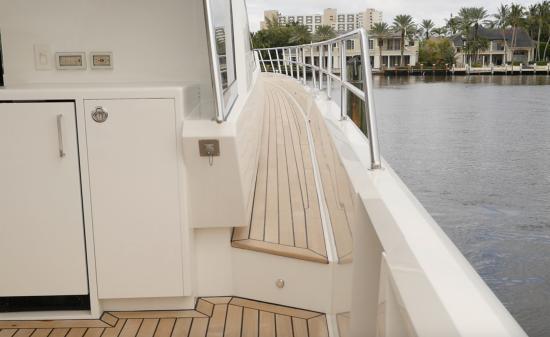


Foredeck
The foredeck has wide walkways with 31” (78.74 cm) high safety rails. These 1¼” diameter (3.175 cm) rails are rugged and welds are smoothly polished. The stanchions are raked forward to accentuate the yacht’s sleek styling. 

The foredeck seating area consists of a curving, forward-facing settee across the base of the windshield. Forward is a sun pad with grabrails on either side, stereo controls and speakers, popup lights, beverage holders, and lockers. The teak decking and rails surrounding the sun pad makes it easier to get around, making the foredeck an additional and attractive social space.

The ground tackle consists of an 88.2 lb. (40 kg) Bruce-type anchor on a stainless steel roller pulpit, with 200’ of 3/8” galvanized anchor chain. There’s a Maxwell RC12 hydraulic windlass that feeds the chain into a rode locker just below.
A handy hose bib is mounted alongside to rinse the tackle as it is retrieved. Foot controls are under stainless steel covers to starboard. Both lower and upper helm stations also have remote windlass control.
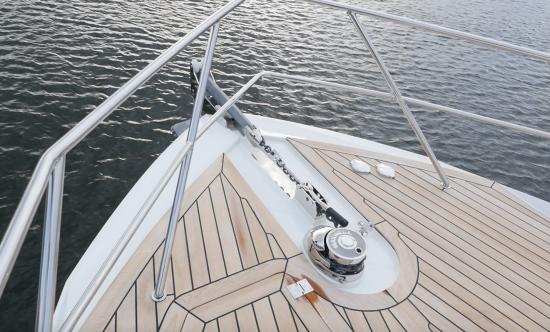
The rode locker is beneath a hatch to port, where the chain is fed through a pipe to pile it in the center. There’s good access to the chain, including a couple of welded steel diamond-pattern steps to let the operator get down in there easily, which is an important detail we rarely see on this size yacht.

Flying Bridge
The flying bridge is accessed from a ladder in the cockpit, and the top is protected by a stainless steel gate. There’s a helm station on centerline forward behind a fiberglass surround topped with a stainless steel rail that’s 31” (78.74 cm) high, and a molded fiberglass venturi-style wind block forward.




The upper helm has much of the same equipment as the lower helm station. Two touchscreen Garmin GPSMap multifunction displays anchor the top half of a two-tiered dashboard. The upper panel has a compass on centerline with an integrated 4” (10.16 cm) instrument display and an autopilot control above.

The flying bridge helm seats are a pair of Stidd low-back admiral chairs, upholstered in Ultraleather. The helm seat is on centerline and another to port. These seats are on lower pedestals and work with the seated-height helm station. They have flip-up armrests and multiple adjustment points.


Outdoor entertaining is easy on the flying bridge. A “J-shaped” settee curving around a table shaped for the purpose to starboard. Opposite is a wet bar with a sink, refrigerator drawers, and an icemaker.



The flying bridge hardtop is set upon stainless steel stanchions and is 6’9½” (207 cm) off the teak deck. The fabric sunroof opens at the push of a button.



Open deck space aft places an Aurora Firemagic gas grill out from beneath the hardtop. The space is so open it almost feels like a boat deck, but it’s not. Instead, it’s encircled by a fixed rail that’s 31” (78.74 cm) high. This makes the space usable for loose lounge chairs, a café table and chairs, or even a group yoga session as the sun comes up.

Salon
Access to the salon is from the aft deck, through a two-part automatic door that slides open 6’ (1.829 m) wide. Once inside, we’re greeted by a pair of facing 73½” (186.7 cm) settees and a loose round cocktail table. There’s a carpeted sole and the overhead is 6’9” (205.7 cm). The large aft side windows are tinted.





The formal dining area is forward of the seating area and seats six in loose chairs. A U-Line wine chiller built into the aft side of the galley cabinets, handy to the dining table. Also handy is a breaker panel concealed in the port bulkhead.

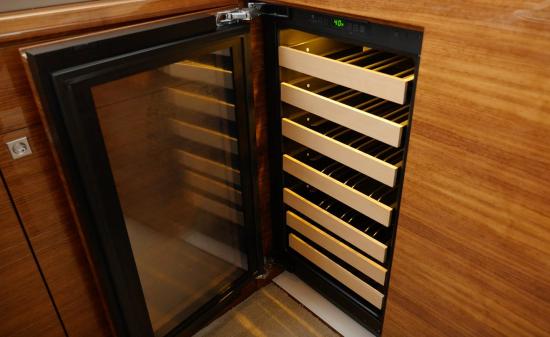

A credenza that is to starboard has a glossy finish on its horizontal-grain veneer and serves as a sideboard. The forwardmost drawers are a pair of Sub-Zero refrigerator drawers, handy to the galley, the helm, and anyone else.



Galley
The galley is to port opposite the helm station and is up one 8½” (21.59 cm) step, where we trade the carpet for wide-planked manufactured-wood decking. Natural-stone counters are interrupted only by the Miele induction cooktop and underhung double stainless steel sink. We would like to see fiddles, or at least a lip, on the counter edges to help contain spills.

A Miele oven and dishwasher are built into the glossy kitchen joinery. More refrigerator and freezer space are in the galley in two more Sub-Zero drawers. Overhead cupboards stow more galley gear and even have a built-in Miele vent fan for the cooktop.

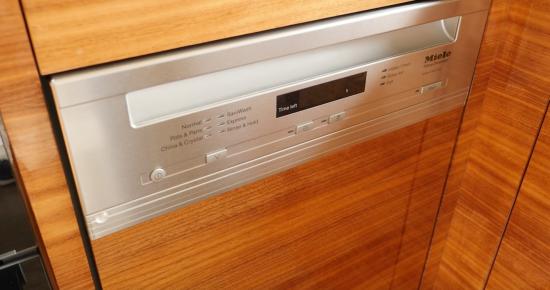


Helm
The main helm is to starboard, on the same raised deck as the galley opposite. The helm dash consists of an angled upper pod on stainless stanchions. There’s a lower console with an angled top panel and some varied geometry where the switches and instruments mount.

On the upper pod are a pair of touchscreen Garmin GPSMap Multifunction displays. Between the two displays are, from the top, a dedicated 4” (10.16 cm) Garmin autopilot control, a rudder indicator and a networked 4” (10.16 cm) instrument that can be set to show key data. The autopilot control at the top of the pod is in the line of sight, but we would like a remote on the outboard armrest, and the whole pod lowered.

The helm’s lower console has the touchscreen C-Zone digital switching control, the Caterpillar port engine monitoring unit, the Seakeeper gyro stabilizer control, the starboard engine monitoring unit, and the Kohler genset control unit. There’s a compass on centerline, lined up with the hub of the vertical steering wheel. It is flanked by the windshield wiper control and Side Power bow and stern thrusters to port, and the ZipWake interceptor tabs and ACR remote control spotlight control to starboard.
All the way to starboard is the ZF throttle and shift binnacle, with engine start buttons and electrical system push buttons directly beneath. The remote mic for the VHF is below that, and the engine controls as well as bilge-pump breakers.





The Stidd Admiral low-back helm chair is 20½” (52.07 cm) wide. It’s built around a powdercoated stainless steel frame, has a flip-down footrest, and adjusts for optimal helm position, and also can serve as a leaning bolster.

The windshield comprises of three panes at a steep rake, and each pane has its own wiper and freshwater washer. The mullions in the corners and between the panes are robust to help support the flying bridge, and so they do take some getting used to. Note the defoggers and dark dash material to reduce glare.
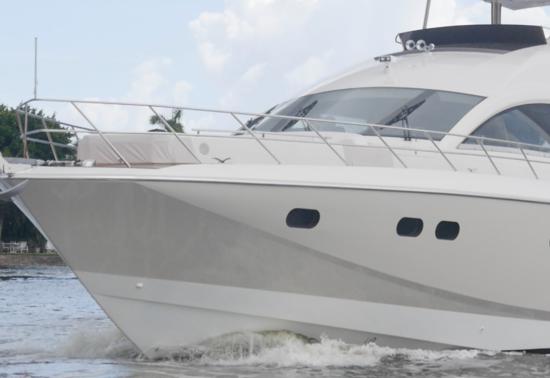

A Note on Docking Control for Owner/Operators
In addition to the two helm stations, there is a ZF wired remote that plugs into a jack on the aft deck and has a 20’ (6.096 m) cable, allowing the skipper to control main-engine throttle and shift as well as bow and stern thrusters. Because the thrusters are hydraulic, the user can take on docking with great confidence since they won’t overheat and trip the breakers as electrical thrusters might do.
There’s an additional jack on the flying bridge on the aft end of the al fresco galley console for the control device.
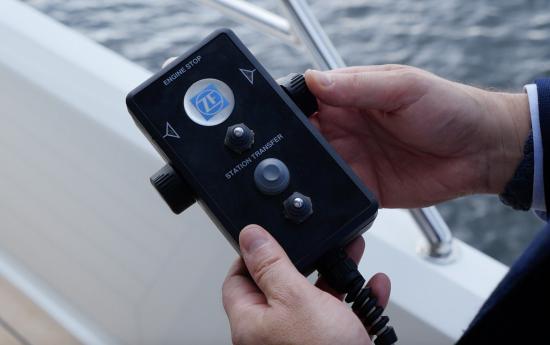
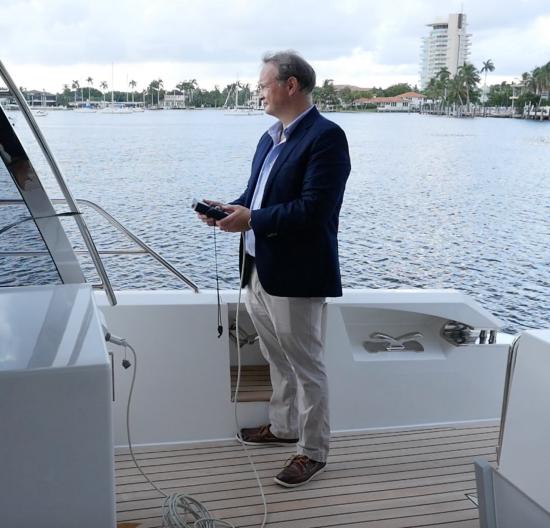

Accommodations
The companionway is located to port of the helm and is slightly to starboard of center and measures 25” (63.5 cm) wide. There are seven steps down to the “lobby” as CL Yachts calls this area.


The lobby is carpeted and offers access to all four staterooms and the starboard guest stateroom head, which serves as the day head.

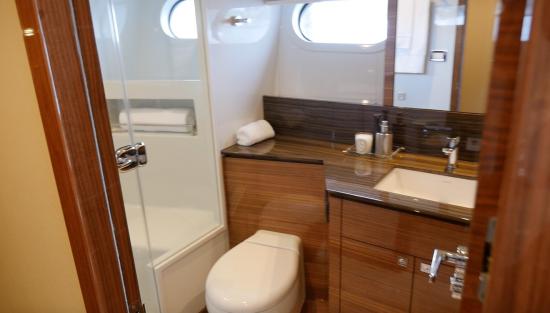
The master stateroom has its own passageway that is three steps down aft from the lower-deck lobby. The passageway has a locker with a bifold door concealing a stacked washer and dryer.
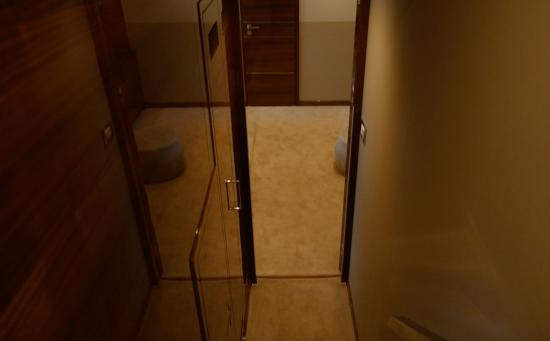


The master stateroom has 6’6” (1.98 m) headroom and an athwartships berth to starboard measuring 66” by 78” (167 cm by 198.1 cm) that opens up the space, taking advantage of the boat’s 19’8” (5.99 m) beam.

A loveseat opposite the berth is 38½” (97.79 cm) wide loveseat with an upholstered ottoman/coffee table, which is something we rarely see on a boat this size. The loveseat has a pop-up flatscreen TV outboard of it, and the entertainment center electronics are handy but out of sight in a locker forward.



Large hullside windows make the most of the master stateroom’s size and overhead height, and some impressive curved joinery details on the overhead. The teak trim has indirect LED lighting and is varnished to a high gloss.

The master nightstands to either side of the berth have AC outlets, USB ports, and LED reading lights. Opposite the bed a 40” (101.6 cm) popup flatscreen TV that rises above the loveseat. There’s a cedar-lined walk-in closet in the master as well, with its own hullside window.


The master head has a double-sink vanity topped in natural stone, large mirrors, and vanity cabinets to stow toiletries. The walk-in shower is lined in the same stone and has a tempered glass door and a large hullside window to port. The toilet, like the other four on the boat are Techma Silence Plus with freshwater flush.



Bow Stateroom
The VIP stateroom is located all the way forward and is en suite. The stateroom has an overhead measuring 6’3½” (196.8 cm) and hullside windows. Behind that full-length mirror to starboard is a cedar-lined hanging locker.

Four large drawers beneath the foot of the berth add stowage. Because the berth is in the bow, it is raised to 3’7” (109.2 cm) high, a bit of a climb in, so there are two steps to either side to make it easier. There’s 2’10” (86.36 cm) of headroom above the berth.

The VIP head has a separate, walk-in shower with tempered glass door, natural light from a hullside window, and a sink with large mirror above and toiletry stowage beneath.

Double Guest Staterooms
Between the master and VIP off the passageway are two en suite guest staterooms. They both have 6’6” (1.98 m) of headroom at the entry. The twin berths measures 73” by 27” (185.4 cm by 68.58 cm) with 3’6” (106.7 cm) over the heads of the berths.
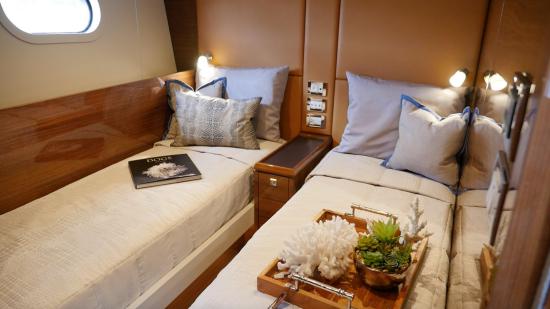
Performance
The CLA76 Flybridge has an LOA of 77’7” (23.65 m), a beam of 19’8” (5.99 m), and a draft of 5’5” (1.65 m). With a displacement of 105,000 lbs (47,500 kg), 264 gallons (999 L) of fuel, 200 gallons (757 L) of water and four people aboard, we had an estimated test weight of 110,854 lb. (50,283 kg).

Powered with a pair of 1,136-hp Caterpillar C18 ACERTs matched to ZF 550A marine gears and 5-blade S-class propellers on straight shafts, we reached a top speed of 29.7 knots (55.0 kmph) at 2320 rpm. Best cruise was 10.1 knots at 1000 rpm, where she burned 14 gph (53.0 lph) for a range of 682 nautical miles (1,262 km).
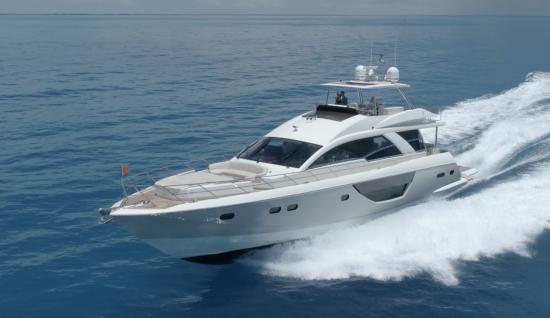
The fuel economy leveled off at 0.3 nmpg (0.15 kmpl) at rpm levels above 1750 rpm, where she did 19.8 knots (36.67 kmph), with a fuel burn of 63.0 gph (238.5 lph) and a range of 297.2 nautical miles (550 km). Our test day had seas that were well within the conditions the yacht could run in comfortably, but it did affect our top-end speed – we think she would have gone a bit faster in flat conditions.

For acceleration, the CLA76 Flybridge accelerated from zero onto plane in 9.7 seconds and on to 20 knots in 12.6 seconds. Her ZF 550A transmissions have a 10-degree down angle, which helps provide lift to get on plane more quickly, and is a more efficient angle than a more typical 14-degree down angle.

Handling
On the water, the yacht responded well to steering and throttle controls. Though her hull carries a bit of her volume forward, she still has a sharp entry and a spray rail that reaches all the way to the stem as well as two lower strakes, keeping her dry in the 2' to 4’ (.61 m to 1.22 m) seas we saw on our test.
While she does shed some speed on turns, she has a pleasant inboard lean on hard turns, though there are a lot of structural elements that can obscure sightlines aft, so it’s important to clear space before turning.

Around the docks she’s easy to manage, thanks in no small part to those responsive mains coupled to large props used in conjunction with the bow and stern thrusters, all easily accessible with the wired remote control. We like the versatility of the plug-in remote.

Options to Consider
- Electric sunroof
- Electric salon entrance door
- Watermaker based on make and model
- Tender and water toys
A Note on Options
CL Yachts builds the CLA76 Flybridge to be a well-found yacht and as such, the standard equipment list in the base package is comprehensive. CL Yachts offers different décor and veneer choices, included in the base price, and as a semicustom builder, it is open to customer suggestion and will try to accommodate customer requests on an individual basis on all yachts.
Warranty
- 10-year hull structure
- 2-year stem to stern limited warranty
- Many components carry a warranty
Price
$4,480,000 price as tested.
Observations
The CLA76 Flybridge is a fun boat to drive. That may seem like an odd sentiment with which to wrap up a Captain’s Report that is spelling out excellent construction and systems engineering, and smart design elements, but it needs to be said. The boat is responsive to both throttle and helm commands, takes on high-speed turns without hesitation, and leans her shoulder into the seas to glide along, even when seas are a bit confused at times as we had.
The Michael Peters-designed hull is as good as ever, but the model has seen a bit of evolution topside since she first came out. The bow area has been opened up substantially, with decks to walk around the sun pad and settee. The house is longer, making for a larger salon and also add space to the flying bridge. The aft deck no longer has a transom sun pad, and the tender garage has been traded for the aft crew’s quarters.
And, the interior has seen a completely new design with a galley up that creates a more social main deck and an inviting accommodations layout – win-win in our book.


